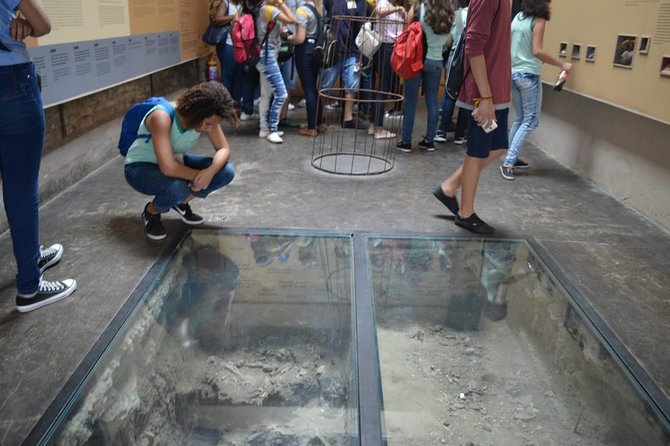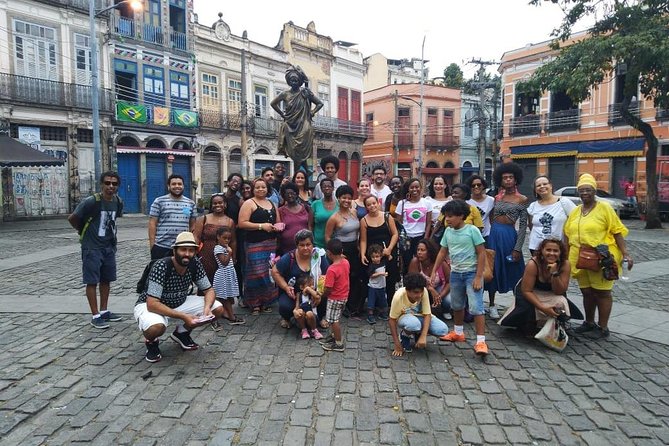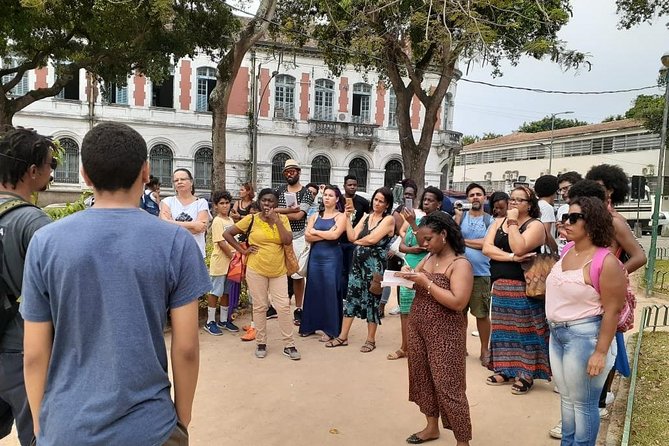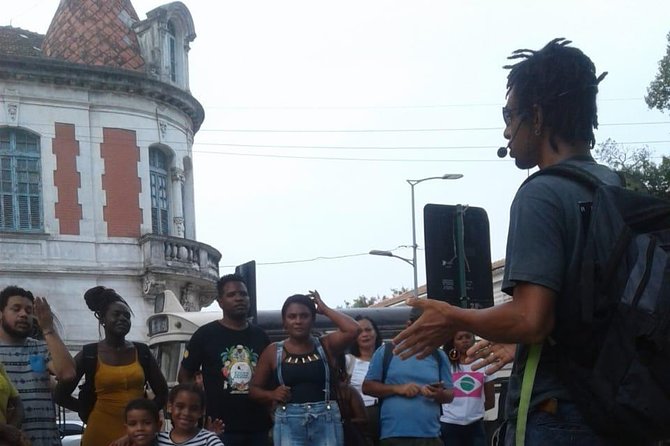Exploring the historic Sa??de district of Rio de Janeiro offers a captivating journey through the Little Africa neighborhood. Hikers can discover the rich cultural tapestry shaped by the African diaspora, encountering significant sites like the UNESCO-listed Cais do Valongo and the vibrant Pedra do Sal. This immersive experience fosters a deeper appreciation for the resilience and contributions of Afro-Brazilian heritage, inviting visitors to uncover the layers of history that have defined this dynamic community. As hikers traverse the scenic waterfront, they’ll find themselves drawn into a narrative that illuminates the region’s past and present.
Good To Know

-
Explore the historic waterfront of Little Africa, a district in Rio de Janeiro that celebrates the African heritage and legacy in the city.
-
Discover the Cais do Valongo, a UNESCO World Heritage site that serves as a former slave port, offering a poignant connection to the transatlantic slave trade history.
-
Visit the Museum of New Blacks, which showcases the Afro-Brazilian contributions and history, providing insights into the community’s resilience and enduring legacy.
-
Experience the vibrant Pedra do Sal, known for its Afro-Brazilian cuisine and historical significance, serving as a hub for cultural celebration.
-
Hike through the Morro da Conceição, a hilltop that provides a unique perspective on the cultural landscape and the city’s development narrative.
Historical Significance
Little Africa has long been named and recognized for its historical significance in Rio de Janeiro. The area was named by artist Heitor dos Prazeres in the early 20th century, representing the African heritage in Brazil, particularly along the city’s waterfront.
This vibrant neighborhood has been a significant site for celebrating and raising awareness of black cultural heritage, marking the history of Rio de Janeiro and Brazil. The area’s key historical sites, such as the Cais do Valongo (a former slave port now a UNESCO World Heritage site), showcase the profound impact of the African diaspora on the city’s development.
You can also read our reviews of more hiking tours in Rio de Janeiro
Key Cultural Sites

Several key cultural sites dot the Little Africa tour, offering visitors a deeper understanding of the area’s rich African heritage.
The Cultural Center Tia Ciata highlights the legacy of an important figure in the African heritage movement.
The Museum of New Blacks showcases the contributions and history of Afro-Brazilians.
The Cais do Valongo, a UNESCO World Heritage site, marks the former slave port.
Pedra do Sal is known for its historical significance and vibrant Afro-Brazilian cuisine.
These sites provide a comprehensive look into the African influence that has shaped the culture and identity of Rio de Janeiro.
Walking the Waterfront

Along the waterfront of Rio de Janeiro’s historic Sa??de district, visitors can embark on a captivating journey through the heart of Little Africa. This area, named by artist Heitor dos Prazeres, is a testament to Brazil’s African heritage.
Strolling along the Cais do Valongo, a UNESCO World Heritage site, offers a profound connection to the history of the transatlantic slave trade. Nearby, the Pedra do Sal is renowned for its vibrant bars and restaurants serving Afro-Brazilian cuisine, creating a lively atmosphere that celebrates the community’s resilience.
Through this waterfront exploration, travelers gain a deeper understanding of the cultural richness that defines Little Africa and its enduring legacy within Rio de Janeiro.
Honoring African Heritage
Immersed in the vibrant spirit of Little Africa, visitors uncover the powerful ways this community honors its African heritage.
The tour highlights key sites like the Museum of New Blacks, which celebrates the contributions of Afro-Brazilians.
At Pedra do Sal, visitors experience Afro-Brazilian cuisine and the area’s historical significance.
The Cais do Valongo, a UNESCO World Heritage site, serves as a poignant reminder of the region’s past as a slave port.
Throughout the tour, the rich cultural legacy of African influence in Rio de Janeiro comes alive, fostering greater understanding and appreciation for the diverse roots that shape the city’s identity.
Exploring the Neighborhoods

Visitors frequently commence their Little Africa tour in the Saúde District, where they can explore Harmony Square and uncover the poignant history at the Museu dos Pretos Novos.
The tour then leads them to the Valongo pier, a UNESCO World Heritage site that served as a slave port.
In the neighboring Gamboa area, travelers visit the Hanging Garden and Morro da Conceição, which marks the boundary between the city center and the suburbs.
Throughout the journey, participants gain a deeper understanding of Afro-Brazilian culture and the profound impact it has had on Rio de Janeiro’s history and identity.
- 7-Hour Island Adventure: Fernando De Noronha Ilhatour
- Private Tour: Rio City Essentials Including Christ the Redeemer and Sugar Loaf
- Paragliding or Hang Gliding Included Pick up and Drop off From Your Hotel.
- Christ the Redeemer + City Tour: Transfers, Local Guide and Tickets.
- Christ the Redeemer, Selaron, Cathedral, Maracana, Sambadrome Half-Day Tour
- Private City Tour of Rio De Janeiro
Valongo Slave Port
The Valongo pier stands as a UNESCO World Heritage site, a poignant reminder of Rio de Janeiro’s past as a major hub for the transatlantic slave trade.
From 1811 to 1831, over 900,000 enslaved Africans arrived at this notorious market and disembarkation point.
Today, the Valongo Wharf Archaeological Site preserves the remnants of this shameful history, providing visitors with a somber yet meaningful opportunity to reflect on the profound impact of the slave trade on Brazil’s society and culture.
Guided tours of the site offer a window into the lives and struggles of those who endured the horrors of the Middle Passage, honoring their memory and the ongoing fight for racial justice.
Museu Dos Pretos Novos
Nestled in the heart of Rio de Janeiro’s historic Saúde district, the Museu dos Pretos Novos stands as a haunting testament to the city’s dark past as a major hub in the transatlantic slave trade.
The museum’s exhibits powerfully convey the plight of the "new blacks", enslaved Africans who perished upon arrival in Brazil. Visitors can explore the clandestine cemetery where these victims were hastily buried.
The museum’s mission is to honor the memory of the enslaved and educate the public about the horrors of the slave trade. Its poignant displays provide a somber yet vital glimpse into a chapter of history that shaped Brazil’s cultural landscape.
Morro Da Conceição
One of the key stops on the Little Africa tour is the Morro da Conceição, an area marking the boundary between Rio de Janeiro’s city center and the surrounding suburbs.
This hilltop offers visitors a glimpse into the city’s historical context. Participants will have the opportunity to explore this significant landmark, learning about its role in shaping the cultural landscape of Rio.
The tour provides insights into the Afro-Brazilian heritage, highlighting the area’s connection to the broader narrative of the city’s development.
Visitors can expect to spend around an hour discovering the unique character and significance of the Morro da Conceição during the Little Africa experience.
Frequently Asked Questions
Can I Take Photos During the Tour?
According to the overview, participants are generally allowed to take photos during the Little Africa Tour. The tour itinerary and logistics do not mention any restrictions on photography, so visitors can likely capture the cultural sights and experiences along the way.
Are There Any Restroom Facilities Along the Route?
Yes, there are restroom facilities available along the Little Africa tour route. Participants can access public restrooms at various points throughout the tour, ensuring convenience and comfort during the cultural exploration.
What Is the Total Walking Distance of the Tour?
The Little Africa Tour has a total walking distance of approximately 2-3 miles. The tour itinerary covers the Saúde District and Gamboa Neighborhood, allowing visitors to explore the historical and cultural sites of this vibrant area in Rio de Janeiro.
Can I Bring My Own Food and Drinks?
Yes, visitors are welcome to bring their own food and drinks on the Little Africa Tour. However, there are also several restaurants and bars featured along the route for those who prefer to sample local Afro-Brazilian cuisine.
Do I Need to Wear Any Specific Clothing or Shoes?
The Little Africa tour doesn’t require any special clothing or shoes. Comfortable walking shoes and casual attire are recommended to explore the area comfortably. Guests should dress appropriately for the weather and be prepared for some walking during the tour.
The Sum Up
Hiking through Little Africa in Rio de Janeiro offers a profound culture. Visitors can explore the region’s rich African heritage, from the UNESCO-listed Cais do Valongo to the vibrant Afro-Brazilian cuisine. This experience fosters a deeper appreciation for the resilience and contributions of the Afro-Brazilian community, shedding light on the integral role they’ve played in shaping the city’s history and identity.
More Hiking & Trekking Tours in Rio de Janeiro
More Tour Reviews in Rio de Janeiro
Not for you? Here's more nearby things to do in Rio de Janeiro we have reviewed
- Evening Experience at a Carioca Samba School
- Rio de Janeiro: Wake Up and Sail
- Boat Tours in Búzios
- From Rio de Janeiro: Arraial do Cabo Island Day Trip
- Petropolis the Imperial City With Beer Tour and Lunch
- 25 Best Tours in Rio De Janeiro
- 25 Best Guided Tours in Rio De Janeiro
- 3 Best Shore Excursions in Rio De Janeiro
- 9 Best Shopping Tours in Rio De Janeiro
- 18 Best Drinking Tours in Rio De Janeiro
- 24 Best National Park Tours in Rio De Janeiro
- Rio Sunrise Private Tour
